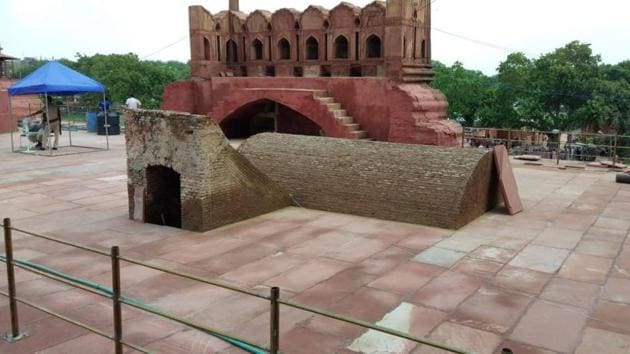Hidden ammunition storage room discovered in Red Fort
The chamber in Red fort may have been originally used to store ammunition although when it was discovered it, the crypt was full of mud and no explosives or firearms were found.
While cleaning the rampart at the Lahori Gate, the main entrance to the 17th-century Red Fort from where the Prime Minister addresses the nation every Independence Day, Archaeological Survey of India (ASI) personnel have stumbled upon a hidden underground chamber.

The chamber may have been originally used to store ammunition although when it was discovered it, the crypt was full of mud and no explosives or firearms were found, ASI officials said on condition of anonymity. They also said the cell was probably built during the reign (1658-1707) of Mughal emperor Aurangzeb or by the British Army after it took control of the Mughal citadel in 1857.
The cell is an oval domed compartment, made of Lakhori brick, which can be accessed through a flight of stairs. It is about six meters in length, two meters in width, and three metres high and located just a few feet away from the pedestal where the flag hoisting ceremony is held every year on August 15.
ASI officials said the cell was buried under a mound of earth and no one from the department had been aware of its existence until now.
After cleaning it up, the ASI has now restored it to its original shape and size.
“It was probably used to keep ammunition as it was a common practice at that time (Mughal or British period) to place ammo under soil to protect it from hot weather as the soil works as an insulator. However, no ammunition was found in the cell. The chamber was just full of mud,” said an ASI official familiar with the restoration work at the fort.
In the past, ASI has stumbled upon explosives and live cartridges on the Red Fort premises.
In February 2017, an ASI team found explosives and live cartridges during the cleaning of the wells inside the fort.
In 2004, ammunition was found in the disused baoli (stepwell) when it was being restored.
A retired police officer, who has served as a part of the Prime Minister’s security unit in Delhi Police, said, “At Red Fort, we check every room or corner for possible threats before Independence Day celebrations. Every corner is sanitised. We have never heard of a century-old hidden underground tunnel ever on the rampart there. If there were any explosives in the rampart, the ground sensor and radar would have detected it.”
ASI officials could not zero in on the exact period of construction of the vault but added that it might have been built after British gained the control of the Red Fort following the end of Mughal rule.
“This will require a study,” said KK Muhammad,a former regional director (north) of the ASI.
“The structure may belong to the period during which the fort was under British control,” said Shama Mitra Chenoy, who teaches history at Delhi University’s Shivaji College,
The Red Fort ramparts are an addition ordered built by Aurangzeb so the cell might have also been constructed during his reign, said an ASI official who was earlier posted at the Red Fort.
“Earlier, the king could see Chandni Chowk from DiwanI-Am through Lahore Gate directly. There was no obstruction in between. At that time, there was a tradition that the people could not turn their back to the ruler. When people would come to the market, there was lot of inconvenience to them. So, Aurangzeb built this rampart, which was also called ‘ghoonghat’ (veil),” said Sohail Hashmi, a history buff who conducts heritage walks.
Chandni Chowk is an ancient market located close to the Red Fort. Diwan-I-Am is a hall in the Red Fort where the Mughal emperors used to receive audiences.
As part of the ongoing fort restoration project, the ASI removed about 2.2 million kilos of dirt from the ramparts recently.An almost two-metre thick layer of earth had to be removed as it was putting pressure on the fortification.
Conservators said soil used to be placed on the terrace to keep ammunition cool or neutralise possible cannonball attacks.
“Water being used for horticulture and rains were causing seepage, thus weakening the rampart. During the cleaning of the rampart, we also discovered an arch and a set of stairs, which were restored too along with the oval domed compartment,” said the ASI official familiar with the restoration work cited above.
After covering the rampart floor with red sandstone, workers are fitting drain pipes on all three sides to prevent water from stagnating on the floor. Some quantity of soil around the flag post on the edge facing Chandni Chowk has been left for a fine coat of green grass.
An old iron fence is also being replaced with a brass railing and an entire arched passage from the rampart to Meena Bazaar, another ancient market, will be paved with red sandstone instead after its bitumen slabs are removed.
“The work at the rampart will be completed in a week or so. Development work at other locations in the fort will temporarily be halted for the August 15 function as the security agencies will take over the fort for security reasons,” said the ASI official.
Stay updated with all top Cities including, Bengaluru, Delhi, Mumbai and more across India. Stay informed on the latest happenings in World News along with Delhi Election 2025 and Delhi Election Result 2025 Live, New Delhi Election Result Live, Kalkaji Election Result Live at Hindustan Times.
Stay updated with all top Cities including, Bengaluru, Delhi, Mumbai and more across India. Stay informed on the latest happenings in World News along with Delhi Election 2025 and Delhi Election Result 2025 Live, New Delhi Election Result Live, Kalkaji Election Result Live at Hindustan Times.






